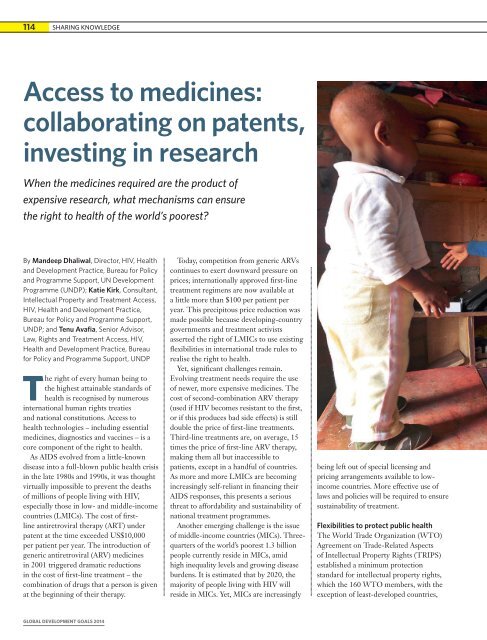FAMBB
FAMBB
FAMBB
Create successful ePaper yourself
Turn your PDF publications into a flip-book with our unique Google optimized e-Paper software.
114 SHARING KNOWLEDGEAccess to medicines:collaborating on patents,investing in researchWhen the medicines required are the product ofexpensive research, what mechanisms can ensurethe right to health of the world’s poorest?By Mandeep Dhaliwal, Director, HIV, Healthand Development Practice, Bureau for Policyand Programme Support, UN DevelopmentProgramme (UNDP); Katie Kirk, Consultant,Intellectual Property and Treatment Access,HIV, Health and Development Practice,Bureau for Policy and Programme Support,UNDP; and Tenu Avafia, Senior Advisor,Law, Rights and Treatment Access, HIV,Health and Development Practice, Bureaufor Policy and Programme Support, UNDPThe right of every human being tothe highest attainable standards ofhealth is recognised by numerousinternational human rights treatiesand national constitutions. Access tohealth technologies – including essentialmedicines, diagnostics and vaccines – is acore component of the right to health.As AIDS evolved from a little-knowndisease into a full-blown public health crisisin the late 1980s and 1990s, it was thoughtvirtually impossible to prevent the deathsof millions of people living with HIV,especially those in low- and middle-incomecountries (LMICs). The cost of firstlineantiretroviral therapy (ART) underpatent at the time exceeded US$10,000per patient per year. The introduction ofgeneric antiretroviral (ARV) medicinesin 2001 triggered dramatic reductionsin the cost of first-line treatment – thecombination of drugs that a person is givenat the beginning of their therapy.Today, competition from generic ARVscontinues to exert downward pressure onprices; internationally approved first-linetreatment regimens are now available ata little more than $100 per patient peryear. This precipitous price reduction wasmade possible because developing-countrygovernments and treatment activistsasserted the right of LMICs to use existingflexibilities in international trade rules torealise the right to health.Yet, significant challenges remain.Evolving treatment needs require the useof newer, more expensive medicines. Thecost of second-combination ARV therapy(used if HIV becomes resistant to the first,or if this produces bad side effects) is stilldouble the price of first-line treatments.Third-line treatments are, on average, 15times the price of first-line ARV therapy,making them all but inaccessible topatients, except in a handful of countries.As more and more LMICs are becomingincreasingly self-reliant in financing theirAIDS responses, this presents a seriousthreat to affordability and sustainability ofnational treatment programmes.Another emerging challenge is the issueof middle-income countries (MICs). Threequartersof the world’s poorest 1.3 billionpeople currently reside in MICs, amidhigh inequality levels and growing diseaseburdens. It is estimated that by 2020, themajority of people living with HIV willreside in MICs. Yet, MICs are increasinglybeing left out of special licensing andpricing arrangements available to lowincomecountries. More effective use oflaws and policies will be required to ensuresustainability of treatment.Flexibilities to protect public healthThe World Trade Organization (WTO)Agreement on Trade-Related Aspectsof Intellectual Property Rights (TRIPS)established a minimum protectionstandard for intellectual property rights,which the 160 WTO members, with theexception of least-developed countries,GLOBAL DEVELOPMENT GOALS 2014


